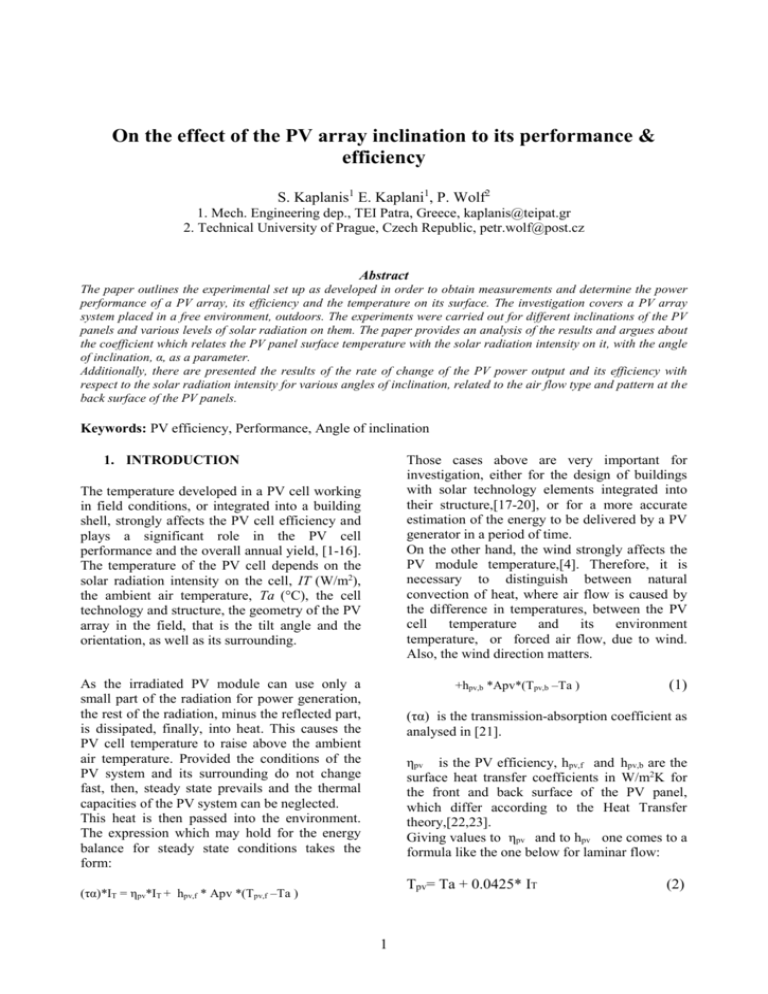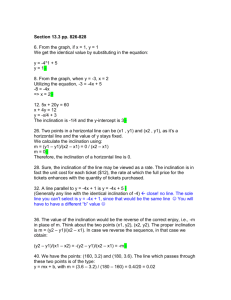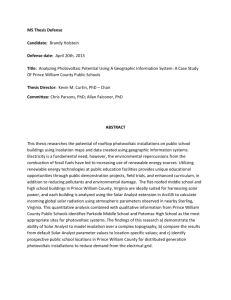iwtpv
advertisement

On the effect of the PV array inclination to its performance & efficiency S. Kaplanis1 E. Kaplani1, P. Wolf2 1. Mech. Engineering dep., TEI Patra, Greece, kaplanis@teipat.gr 2. Technical University of Prague, Czech Republic, petr.wolf@post.cz Abstract The paper outlines the experimental set up as developed in order to obtain measurements and determine the power performance of a PV array, its efficiency and the temperature on its surface. The investigation covers a PV array system placed in a free environment, outdoors. The experiments were carried out for different inclinations of the PV panels and various levels of solar radiation on them. The paper provides an analysis of the results and argues about the coefficient which relates the PV panel surface temperature with the solar radiation intensity on it, with the angle of inclination, α, as a parameter. Additionally, there are presented the results of the rate of change of the PV power output and its efficiency with respect to the solar radiation intensity for various angles of inclination, related to the air flow type and pattern at the back surface of the PV panels. Keywords: PV efficiency, Performance, Angle of inclination Those cases above are very important for investigation, either for the design of buildings with solar technology elements integrated into their structure,[17-20], or for a more accurate estimation of the energy to be delivered by a PV generator in a period of time. On the other hand, the wind strongly affects the PV module temperature,[4]. Therefore, it is necessary to distinguish between natural convection of heat, where air flow is caused by the difference in temperatures, between the PV cell temperature and its environment temperature, or forced air flow, due to wind. Also, the wind direction matters. 1. INTRODUCTION The temperature developed in a PV cell working in field conditions, or integrated into a building shell, strongly affects the PV cell efficiency and plays a significant role in the PV cell performance and the overall annual yield, [1-16]. The temperature of the PV cell depends on the solar radiation intensity on the cell, IT (W/m2), the ambient air temperature, Ta (°C), the cell technology and structure, the geometry of the PV array in the field, that is the tilt angle and the orientation, as well as its surrounding. +hpv,b *Apv*(Tpv,b –Ta ) As the irradiated PV module can use only a small part of the radiation for power generation, the rest of the radiation, minus the reflected part, is dissipated, finally, into heat. This causes the PV cell temperature to raise above the ambient air temperature. Provided the conditions of the PV system and its surrounding do not change fast, then, steady state prevails and the thermal capacities of the PV system can be neglected. This heat is then passed into the environment. The expression which may hold for the energy balance for steady state conditions takes the form: (1) (τα) is the transmission-absorption coefficient as analysed in [21]. ηpv is the PV efficiency, hpv,f and hpv,b are the surface heat transfer coefficients in W/m2K for the front and back surface of the PV panel, which differ according to the Heat Transfer theory,[22,23]. Giving values to ηpv and to hpv one comes to a formula like the one below for laminar flow: Tpv= Ta + 0.0425* IT (τα)*ΙΤ = ηpv*IT + hpv,f * Apv *(Tpv,f –Ta ) 1 (2) Tpv= Ta + λ* IT (5) where λ can be a function dependent on many parameters, like: a. the solar radiation spectrum, or correspondingly the clearness index, Kt, [15,24,25] b. the inclination angle, α, as hpv generally depends on this angle, c. the type of flow, natural or forced flow, and d. the pattern of air flow past the PV panel, ie laminar or turbulent, which determine the value of hpv, [22,23] . It is, therefore, important to design experiments to determine the PV panel performance, its maximum power, Pm and ηpv, associated to the IT and the α value, as parameters. According to the analysis above, as the cases b,c,d are inter-related, the coefficient λ (Km2/W) might well be assumed as a function of the inclination of the module, α, where λ=f(α.) or more accurately from the Heat Transfer theory, is a function of cos(α), [26,27]. All these lead to the conclusion that even with the same solar radiation intensity on two PV cells, which have different inclination angles, one may get different results for Pm, ηpv and Tpv. Figure 1. A PV array positioned with a changing inclination in a free space outdoors. The measurements were done in Patras, Greece in June 2007 with PV modules, SM 55, in outdoor conditions. The wind velocity was less than 1m/s. PV cooling was mostly due to natural air convection and infrared radiation from the PV modules.. The experimental set up is shown by the schematic diagram in fig. 2. The system built to collect and manage data and measure PV module performance, consists of: 1. A data logger, Campbell Scientific CR1000 2. An i-V characteristic portable system , developed and built for this project 3. A Pyranometer Kipp & Zonen, type CMP3 and temperature sensors: thermocouple “T” ( Copper-Constantan) and a portable infra-red thermometer, type Mikron M90 series. The sensors were placed on the back side of the PV module directly on the Tedlar foil. A second thermocouple in a cage was used to measure the ambient air temperature, Ta. Simultaneously, the i-V characteristic of the PV panels were obtained for all cases examined. 4. Software to analyze the i-V data DESCRIPTION OF THE PV SYSTEM DESIGN AND THE EXPERIMENTAL SETUP To determine the function f(α) and draw conclusions on the effect of α on the PV performance, field measurements were taken for different IT and α values. PV cell temperatures, as well as ambient temperatures, were measured in an attempt to fit the data, finally obtained, on a curve with cos(α), as variable. The i-V characteristic curves and therefore, the max. power Pm were both measured and determined for different inclinations and irradiation levels, outdoors. A PV generator in a free space outdoors. PV panels are placed in a free space with an inclination angle, manually fixed, see fig.1. In this mode of experiments, the air flow is rather free depending on the angle of inclination. The differences in the results, as to be presented and discussed, may be attributed to the changes of the air flow pattern, developed in each set, due to the geometry of the PV and its surrounding environment. 2 Figure 1. Schematic diagram of the experimental set up Figure3. Temperature increase, Tdif, vs IT for various inclination angles of the PV array placed on a free environment, outdoors. RESULTS Eq (3) provides that Tdif / IT = λ. Fitting the Tdif / IT measured data onto a curve: The experiments were conducted so that Tpv, Ta, and IT were measured, for various α values from 160 to 750. This inclination is measured from the horizontal position. Pm and ηpv were determined vs IT for predetermined values of the angle of inclination, α. Each measurement lasted for a period of time, as to reach at steady state and get a whole performance profile of a range of IT values under such conditions. The monitoring system showed when steady state conditions were reached. During such periods, the i-V curves were obtained, so that Pm be determined. Then, the relative efficiency, Pm/IT, was calculated. In this set of experiments, the results are rationally interpreted. Tdif increases with IT and takes larger values for small α, as shown in fig. 3; . However, as air flow at the back side of the PV surface changes to turbulent, [15, 22, 26, 27], due to increase in the Grashof number, at about 40-450, we observe a larger drop in Tdif ; see fig. 6, the curve for inclination angle at 460. On the contrary, in high α values, the flow of the air passed by the PV panel turns again laminar or the layers glide over the back PV surface. k0 +k1*cos(α) + k2*cos(α)2 (6) we obtain good results as shown in fig. 4, where the coefficients of the quadratic function take values: k1 = 1.66E-1 k2 = -2.37E-1 k3 = 1.02E-1 and the norm of residuals = 2E-3 Figure 4. Tdiff /IT= λ, the solar radiation coefficient for the PV panel temperature vs cos(α) fitted on a quadratic polynomial fitting. The PV array is positioned in a free space outdoors. Analysis of the data, taken from fig. 3 show that λ coefficient which appears in eq.(3) takes values in the range: [ 0.05 for inclination 650 , 0.035 for 47 0 , 0.04 for 26 0 and 0.045 for 160 ] 3 In the case of the PV array in a free environment, λ values get higher at low and high α angles, as again the flow turns to be laminar, due to low Tpv and low IT. with two different α angles, or the expression was estimated from the data of any curve in fig. 6, which holds for a specific α angle, for a range of IT values. Finally, the rate of change of the PV power output and its relative efficiency vs IT with parameter the angle of inclination, α, are given in figs. 5 and 6, respectively. In addition, the same analysis was followed to obtain values of , (dηpv/dΤ)/ηpv using data between the curve for 470 and 160 This analysis gave a higher value for (dηpv/dΤ)/ηpv. The relative change was estimated to about 1.0%/0C, which verifies the effect that the inclination angle has in the PV performance. The integrated relative change of (dη/dIT)/η over a range of IT that is [(dηpv/dIT)/ηpv]δΙΤ for the same angle of inclination, α, is obtained from fig. 6, through the analysis: [(dηpv/dI)/ ηpv]*δΙ = [V-1oc *(dVoc/dT)*(dT/dI) + I1sc*(disc/dT)*(dT/dI)+FF-1*(dFF/dT)*(dT/dI)]*δΙ The estimation of the expression (dηpv/dI)/ ηpv using the known values of the rate of change of Voc , isc , FF and the rate Tpv changes with IT , taken from fig. 6, provides a theoretical value of -3.7 – 3.8 % for the range of measurements from 800 to 1000 W/m2 On the other hand the analysis of the experimental data in fig. 6 provides a value of 7% at 470 and – 5.56 % at 160 for the same range 800 to 1000 W/m2 Figure 2. PV power increase vs IT for various inclination angles. The figure stands for a PV array positioned in a free space, outdoors. 2. CONCLUSIONS This paper describes the performance measurements and results as obtained by various lay outs of a PV array. The target was to find the dependence of PV output on the inclination and the temperature developed in it. As seen from the fitting results, the coefficient which relates the Tpv with IT was found to fit well on a quadratic polynomial with cos (α). If the temperature had no effect, the PV efficiency would increase by the irradiation increase. As seen in figs. 3,5 and 6 the temperature increase has a strong effect on the PV efficiency and thus in real conditions the efficiency decreases as irradiation increases. The paper succeeded to provide a detailed analysis of the PV performance, as determined by the i-V curves, the relative efficiency and the temperature profiles developed at the back surface of the PV panels. For a PV array positioned in a free space the values of the coefficient which relates Tpv with IT lie within the range: Figure 3. Relative efficiency, Pm/IT vs IT for various inclination angles. The figure holds for a PV array placed in a free space, outdoors. An analysis of the data provided in figs. 3,5 and 6 was attempted. The curve values representing the inclination angles 470 and 260, in fig 3 interrelated with the ones of fig. 6, are chosen for IT values: 700, 800, 900 W/m2. The relative change of the efficiency over the Tdif for both the inclination angles of the PV panel, (dηpv/dΤ)/ηpv, was estimated to take values from about – 0.40%/0C to -0.5%/0C. It is important to argue about the above expression, which was calculated either for the same solar irradiation, IT, on the PV panel and 4 [ 0.05 for inclination 650 , 0.35 for 47 0 , 0.04 for 26 0 and 0.45 for 160 ]. These results were interpreted as influence of the heat transfer coefficient, hpv, which changes with Tpv and with the flow rate which in turn depends on the inclination α, [22, 23, 26, 27]. The change of air flow from laminar to turbulent at about 400-450 is evident in fig. 6. This change is mentioned in [22]. However, at high α values the flow gets laminar, as it was the case for low α values. The reason now is that the IT for high inclinations is low and therefore the Tpv gets low values with a subsequent decrease of the Grashof number. It is essential that the effect of inclination is complex due to changes in air flow and further extended studies are required about the air flow pattern developed. [7] Gxasheka AR, van Dyk EE Meyer EL. Evaluation of performance parameters of PV modules deployed outdoors. Renewable Energy 30 (2005) 611-620 [8] Radziemska E. The effect of temperature on the power drop in crystalline silicon solar cells. Renewable Energy 28 ( 2003)1-12 [9] Ingersoll JG. Simplified calculation of solar cell temperature in terrestrial photovoltaic arrays. J. Solar Eng 1986;108:95-101 [10] Sayigh AAM. Generating electricity from the sun. Renewable Energy Series. Oxford, UK:Pergamon Press, 1991. [11] Lorenzo E. Solar electricity engineering of photovoltaic systems. Spain: Institute of Solar Energy Polytechnic University of Madrid. University Press, 1994 [12] Joshi JC. Thermal evaluation of different types of solar cell modules in sunlight. Renewable Energy 1994;5(3):1761-3 [13] Malik AQ, Salmi Jan Haji Damit. Outdoor testing of single crystal silicon solar cells. Renewable Energy 28 (2003) 1433-1445 [14] Masakatsu Ikisawa et al. Outdoor exposure tests of photovoltaic modules in Japan and overseas. Renewable Energy vol 14 , 1998, pp 95-100 Paretta et al. « Effects of solar irradiation conditions in the outdoor performance of photovolataic modules » Optics communications 153(1998) 153-163 ACKNOWLEDGEMENTS The authors thank the Greek Ministry of Education EPEAEK III Programme and the project ARCHIMIDES for funding this study, as well as the ERASMUS Program of the European Commission for the grant to one of the authors, Mr P. Wolf. [15] REFERENCES [1] Emery K. et al. Temperature dependence of photovoltaic cells, modules and systems. In: Proceedings of 25th IEEE PV specialization conference, Washington, USA; 13-19 May 1996, p. 1275-8 [2] Wilshaw AR, Bates JR, Pearsall NM. Photovoltaic module operating temperature effects. In: Proceeding of Eurosun `96, Munich, Germany, 1996,p.940-4 [3] Jones AD, Underwood CP. A thermal model for photovoltaic systems. Solar Energy 2001;70(4):349-359 [4] Mattei M. et al. Calculation of the polycrystalline PV module temperature using a simple method of energy balance. Renewable Energy 31 (2006) 553-567 [5] van Dyk EE, Scout BJ, Meyer EL., Leitch AWR. Temperature dependence of performance of crystalline silicon modules. S. Afr.J Sci 2000;96:198-200 [6] King DL et al. Temperature coefficients of PV modules and arrays: measurements methods, difficulties and results. Proceedings 25th IEEE photovoltaic specialist conference, 1997. p.11836 5 [16] Bucher K. Solar Energ. Mater. Solar Cells. 47(1997)85 [17] Huang MJ, Eames PC and Norton B. Chapter 454 The Application of Computational Fluid Dynamics to Predict Performance of Phase Change Materials for Control of Photovoltaic Cell Temperature in Buildings. World Renewable Energy Congres VI, 1-7 July [18] Moshfegh B, Sandberg M. Flow and Heat transfer in the air gap behind photovoltaic panels. Renewable Sustainable Energy Rev 1998;2:287301 [19] Brinkworth BJ, Cross BM, Marshall RH and Yang H. “Thermal regulation of photovoltaic cladding” Solar Energy 61 3 (1997) pp169-178 [20] Gan Goshui and Riffat Saffa B. CFD moddeling of air flow and thermal performance of an atrium integrated with photovolatics. Building and Environment vol. 39 issue 7 July 2004,pp 735748 [21] Markvart T. and Castaner L. “ Practical Handbook of Photovoltaics” Elsevier, 2003 [22] Heat and Mass Transfer ‘ Frank M. White, Addison-Wesley, 1988 [23] F. P. Incropera, D.P. DeWitt. “ Introduction to Heat Transfer” John Wiley &Sons, 1996 [24] J.A. Duffie, W.A. Beckman: Solar engineering of thermal processes, J. Wiley&Sons, 1980 [25] Hirata Y., Inasaka T., and Tani T. Output variation of Photovolataic modules with environmental factors-II: seasonal variation, Solar Energy vol 63 No3 1998, pp 185-189 [26] Vliet G.C. Natural Covection Local Heat Transfer on constant –heat flux inclined surfaces, J. Heat Transfer vol 91, Nov. 1969, pp511-516 ] [27] T. Fuji and H. Imura. Natural Convection Heat Transfer from plate with arbitrary inclination Int. J. Heat Mass Transfer, vol.15, 1972, pp 755-767 6







